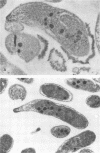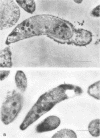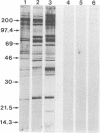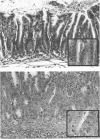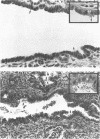Abstract
Control of cryptosporidiosis is currently hampered by the absence of drugs or vaccines proven consistently effective against Cryptosporidium parvum. On the basis of observations that anti-C. parvum antibody has therapeutic effect against cryptosporidiosis, cows were immunized with C. parvum to produce hyperimmune colostral antibody. An antibody-rich fraction was prepared and differentiated from control (nonhyperimmune) antibody by enzyme-linked immunosorbent assay, immunofluorescence assay, immunoelectron microscopy, and in vitro neutralizing titer against DEAE-cellulose-isolated C. parvum sporozoites. Oocyst, purified sporozoite, and merozoite antigens recognized by hyperimmune antibody were defined by Western blot (immunoblot). Hyperimmune antibody recognized antigens common to oocysts, sporozoites, and merozoites, as well as stage-specific antigens. Upon incubation with hyperimmune antibody, sporozoites underwent distinct morphologic changes characterized by progressive formation and eventual release of membranous sporozoite surface antigen-antibody complexes, similar to the malaria circumsporozoite precipitate reaction. The infectivity of sporozoites having undergone this reaction was neutralized. The reaction was minimal or absent on sporozoites incubated with control antibody. To determine therapeutic effect in vivo, persistent C. parvum infection was established in adult severe combined immune-deficient (SCID) mice by oral inoculation with 10(7) oocysts. At 5 weeks postinfection, infected mice were treated for 10 days with hyperimmune or control antibody by inclusion in drinking water and daily gavage. Fecal oocyst shedding and infection scores in the gastrointestinal tract and gall bladder/common bile duct in hyperimmune antibody-treated mice were significantly lower than those in the control antibody-treated mice. Hyperimmune bovine antibody prepared against C. parvum may provide a first-generation therapy for control of cryptosporidiosis. Additionally, the defined antigens can be evaluated as subunit immunogens to produce better-characterized polyclonal antibody for control of cryptosporidiosis or as targets for monoclonal antibody-based immunotherapy.
Full text
PDF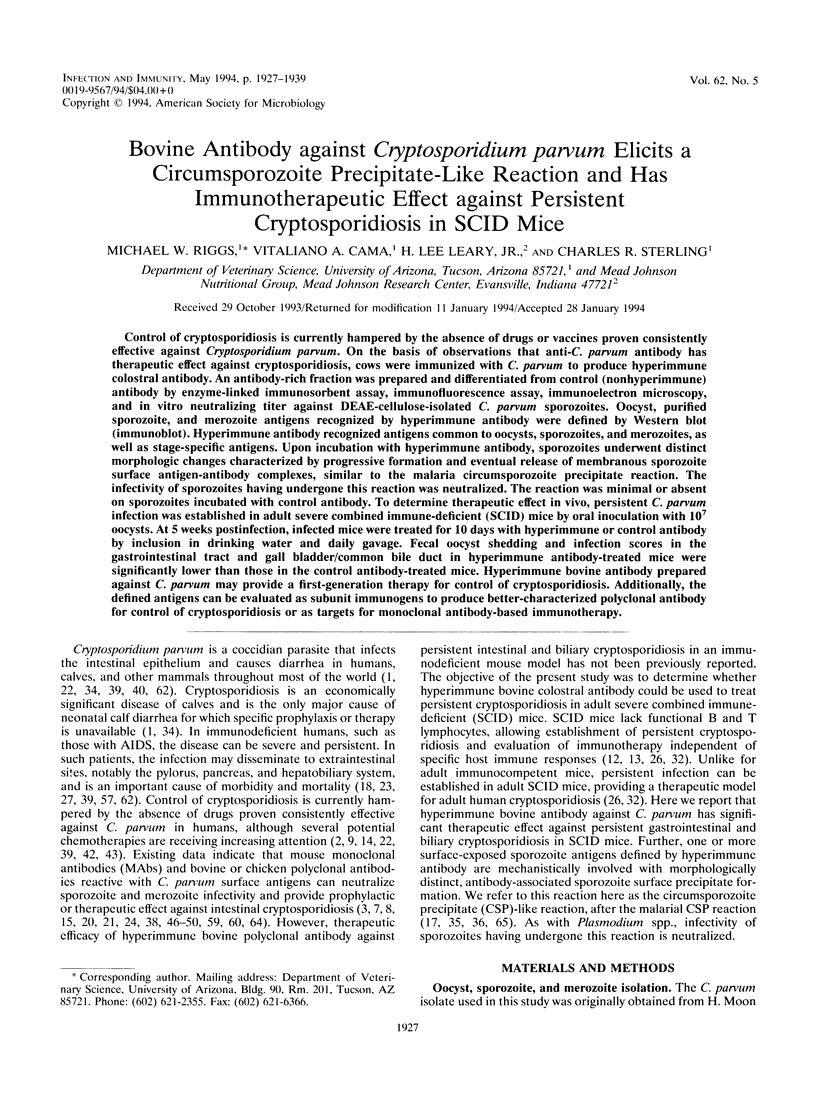
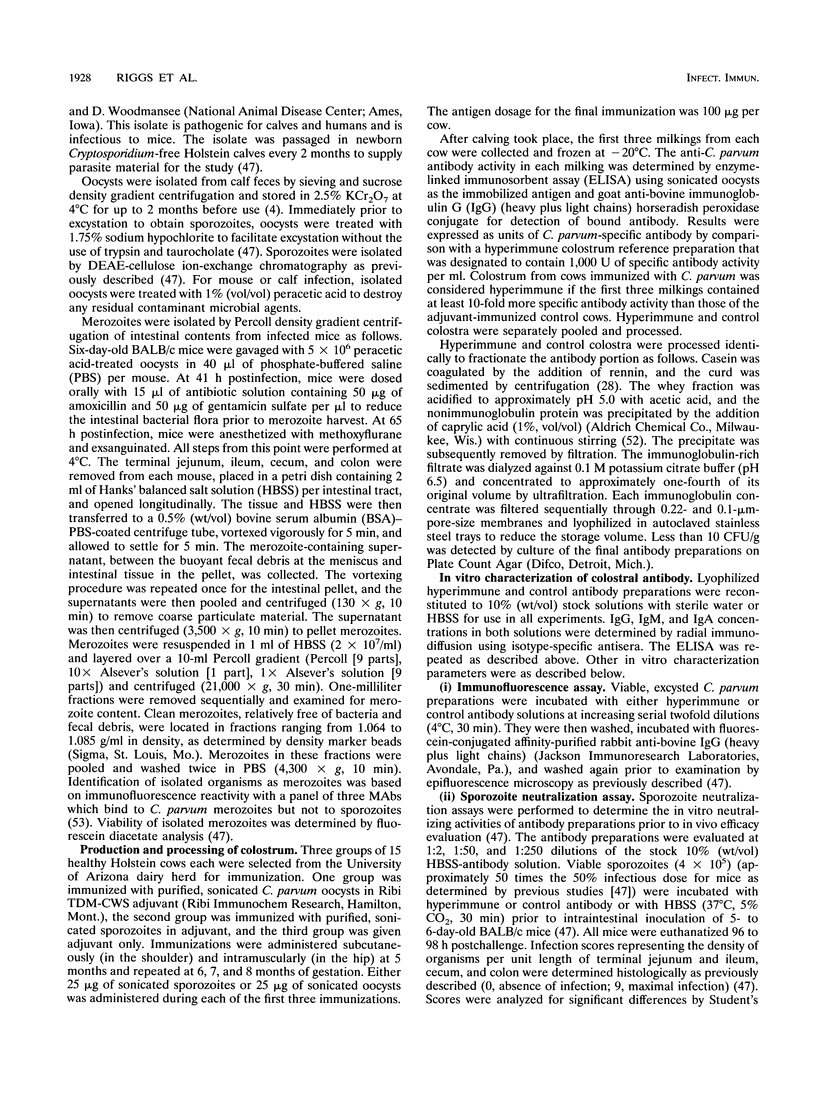
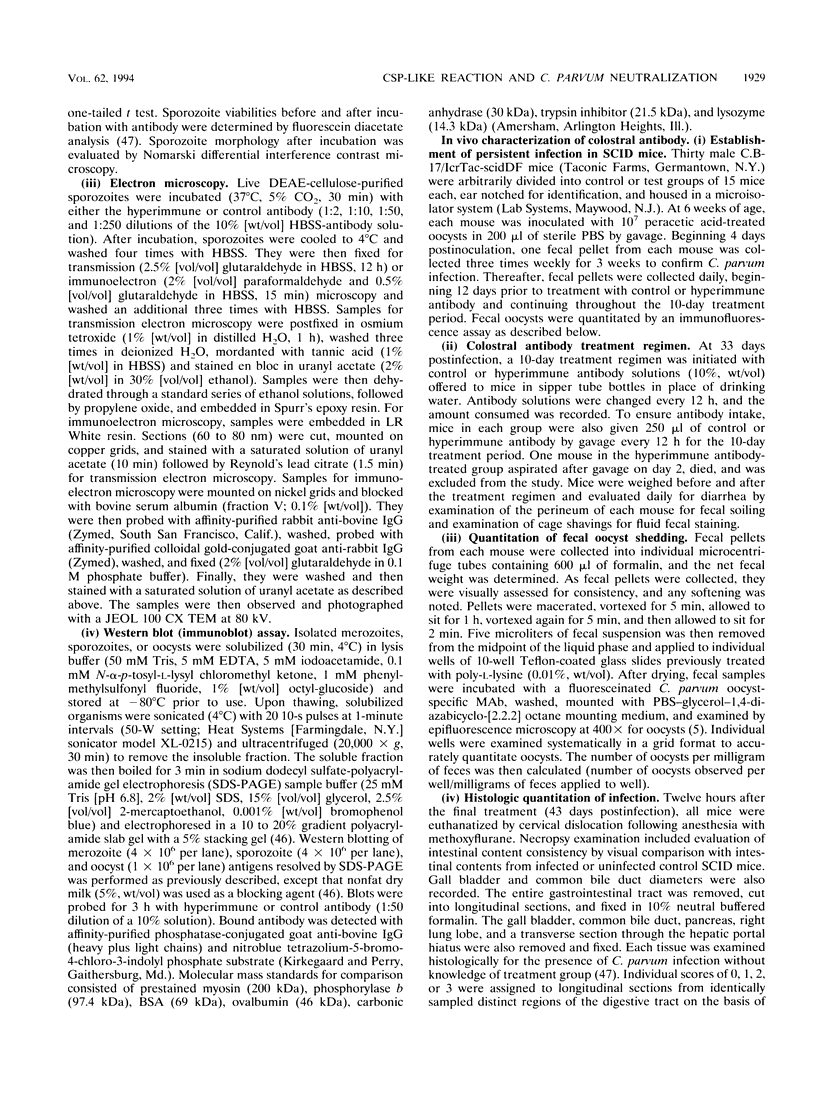
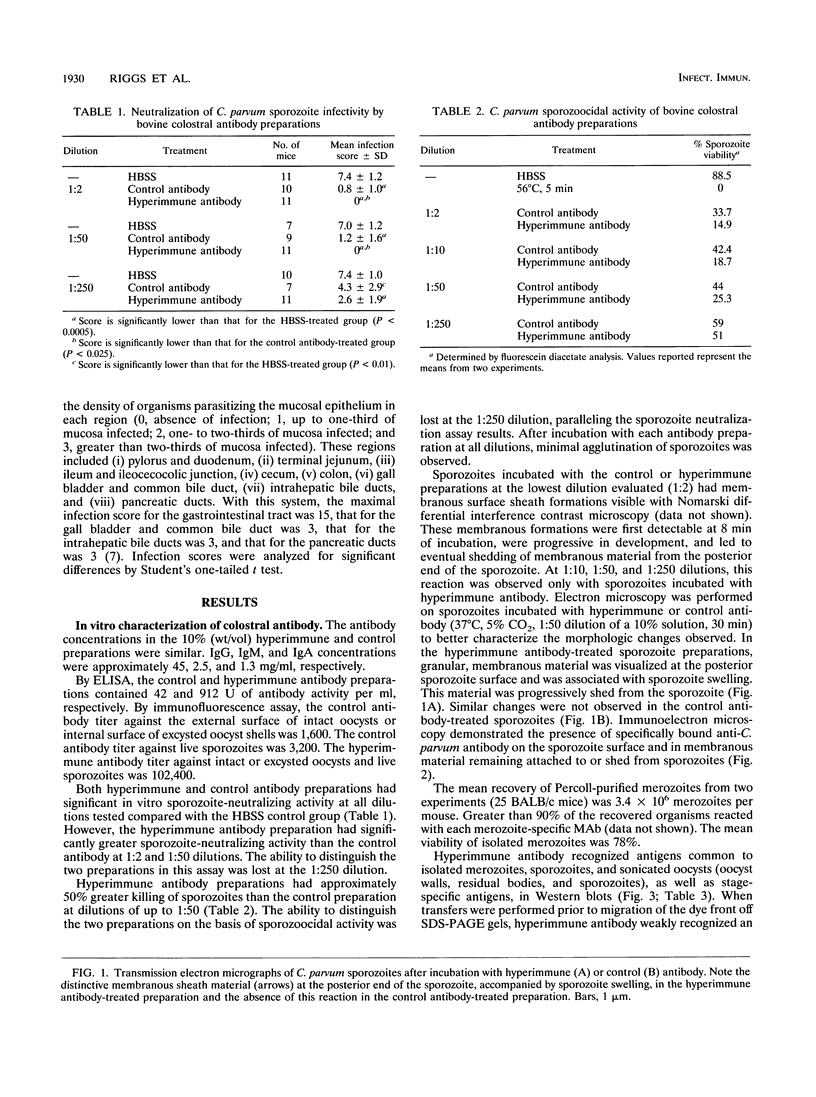
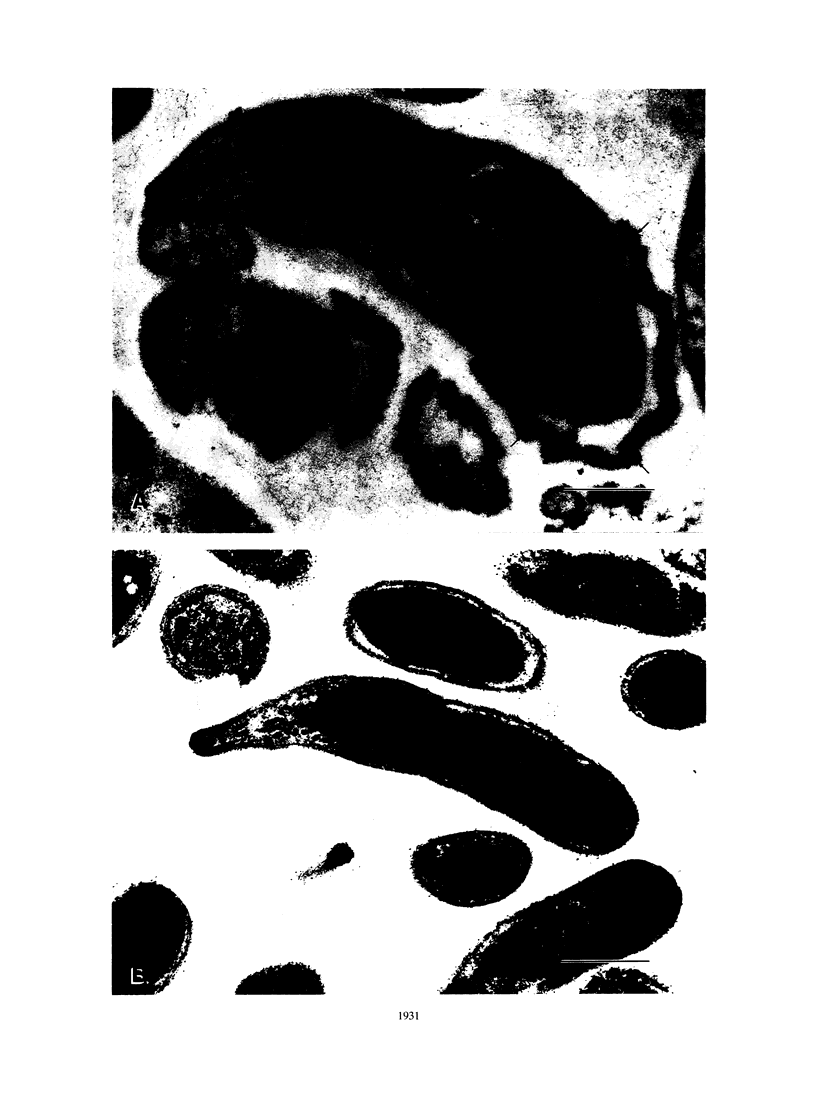
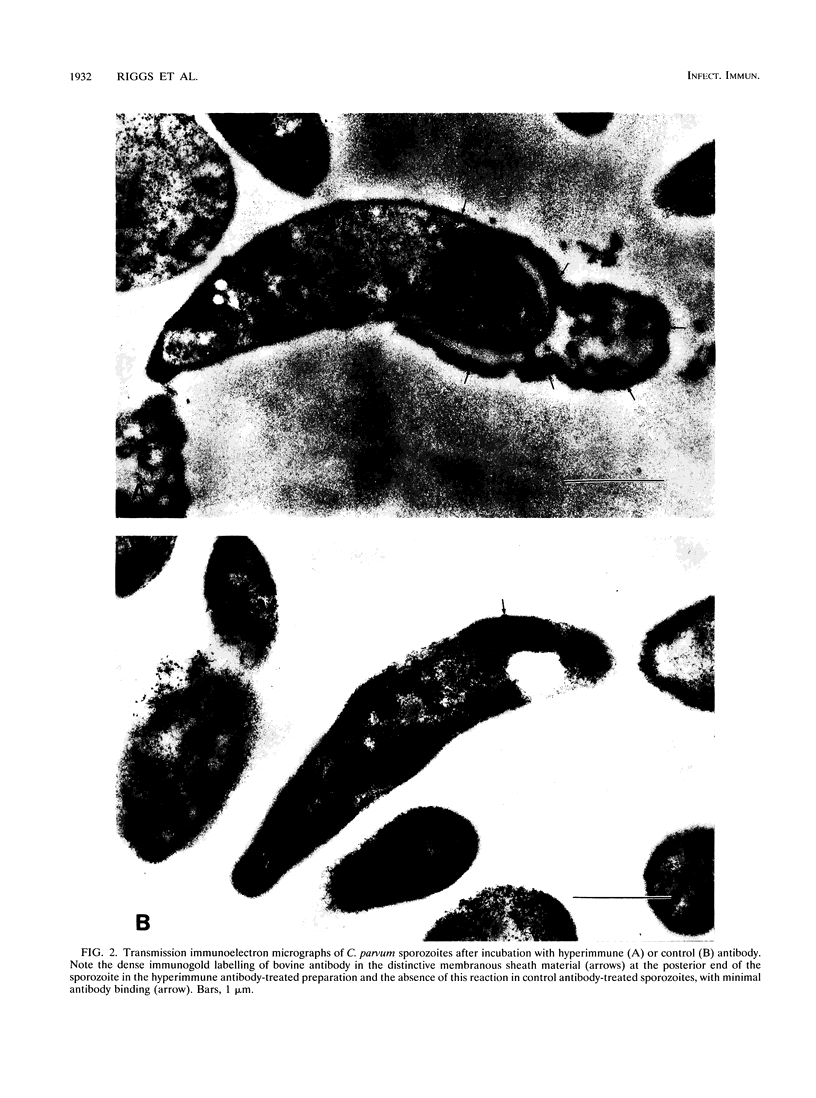
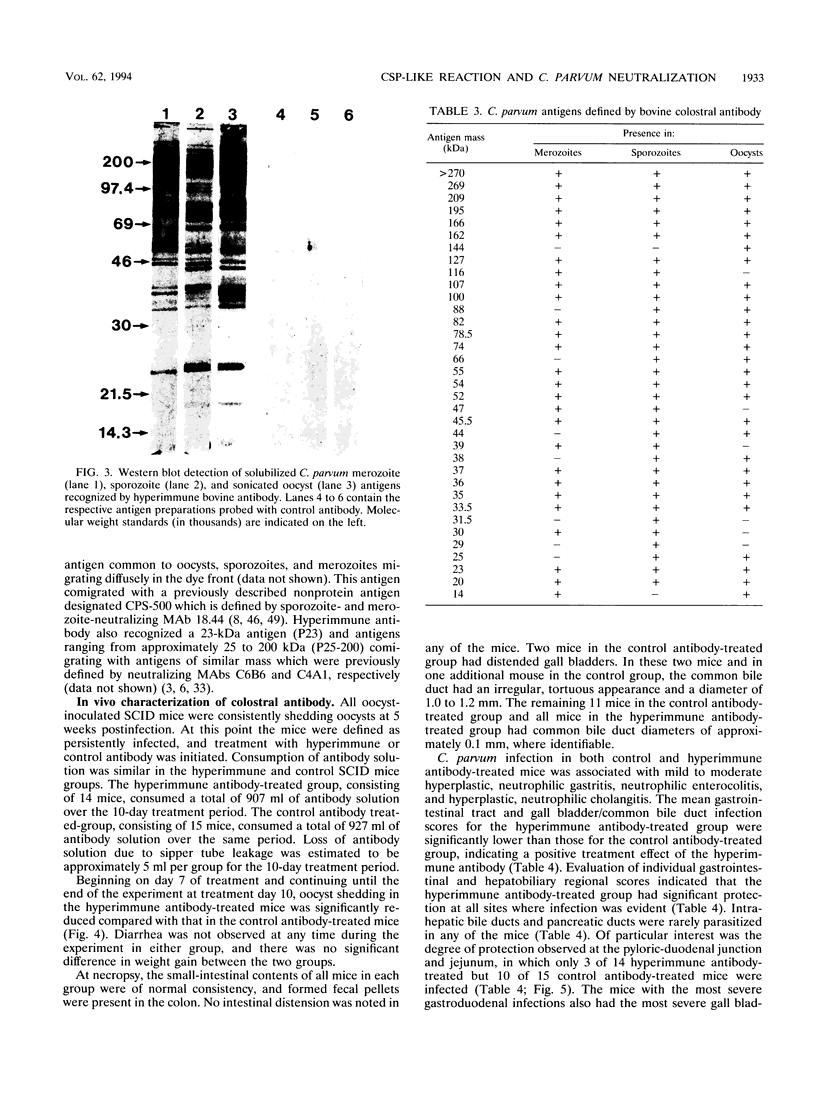
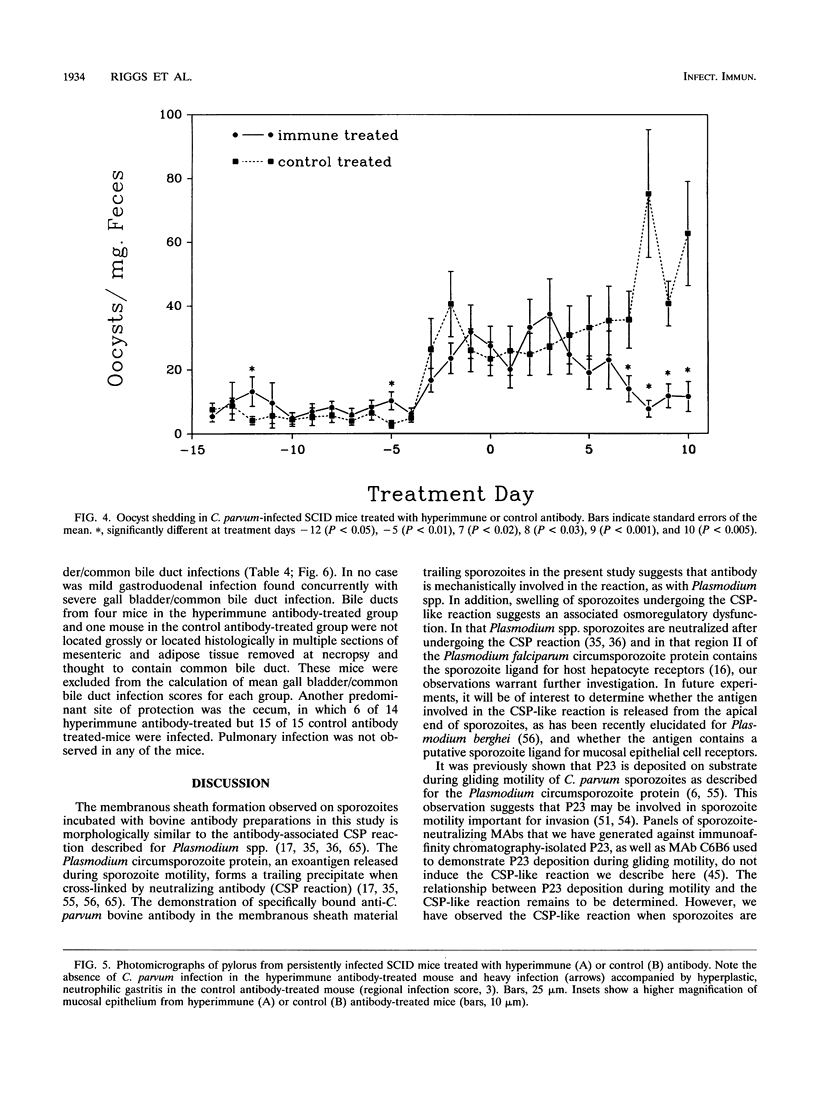
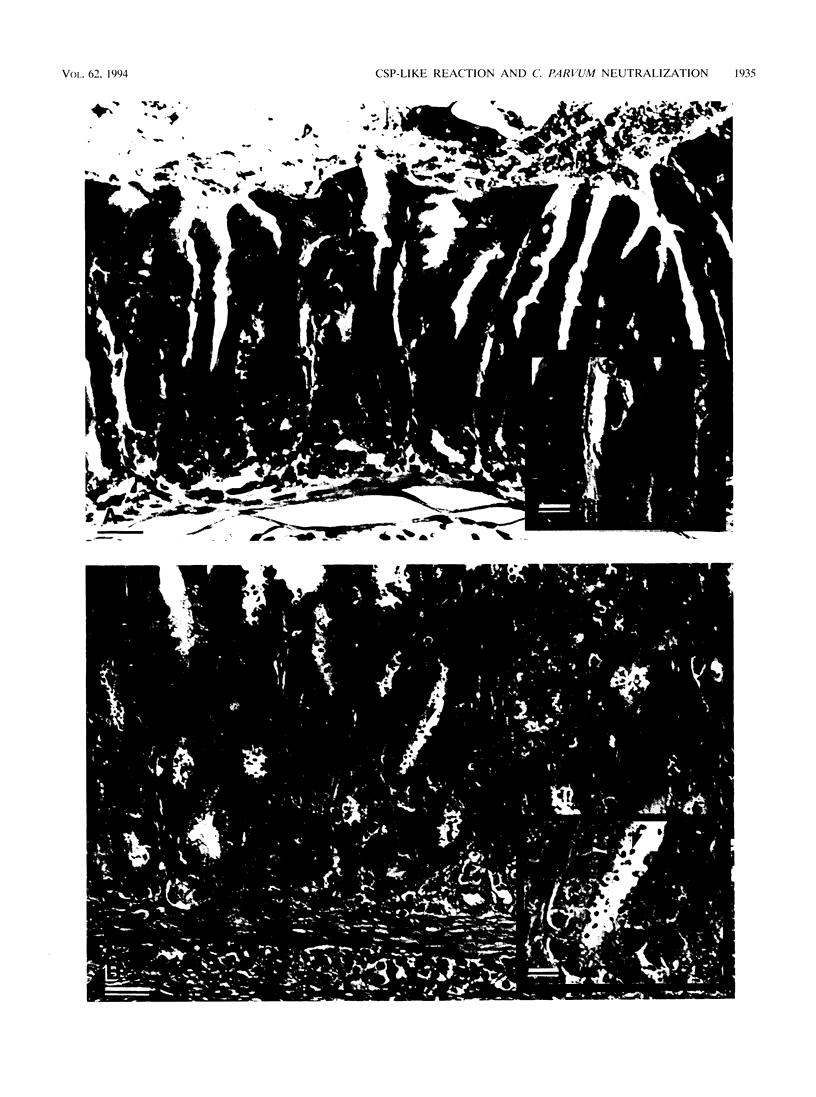
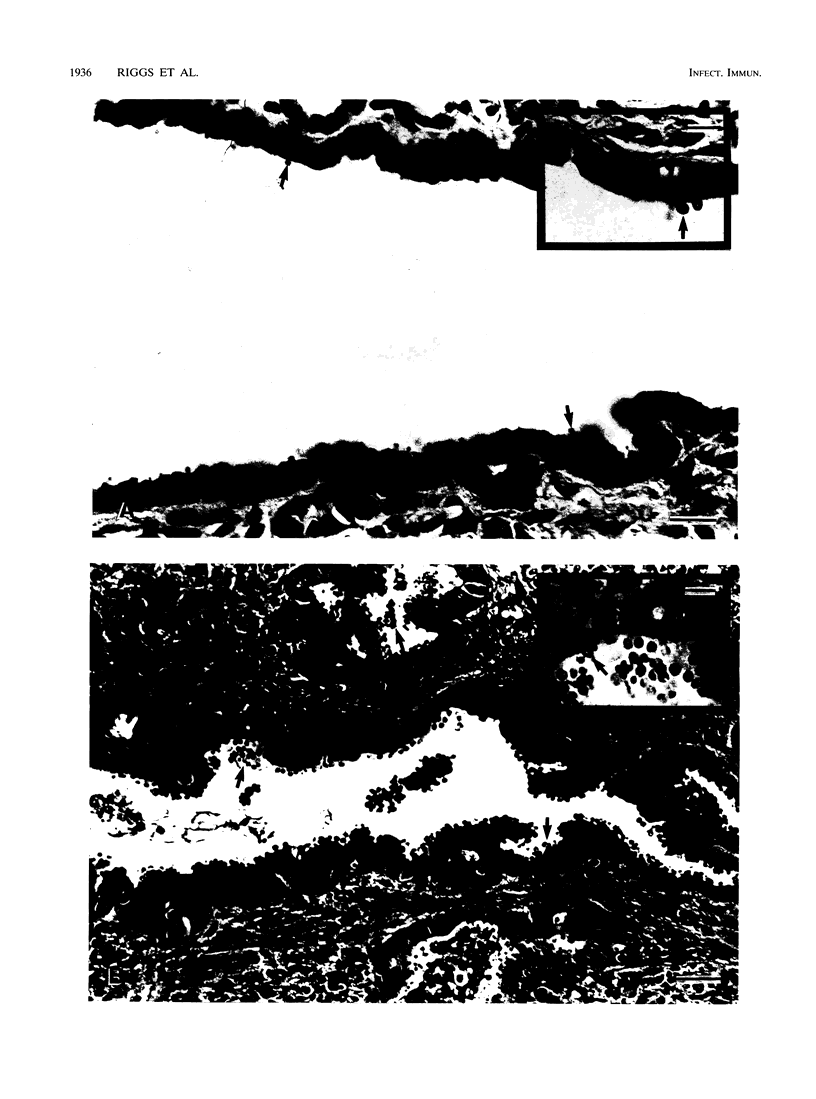

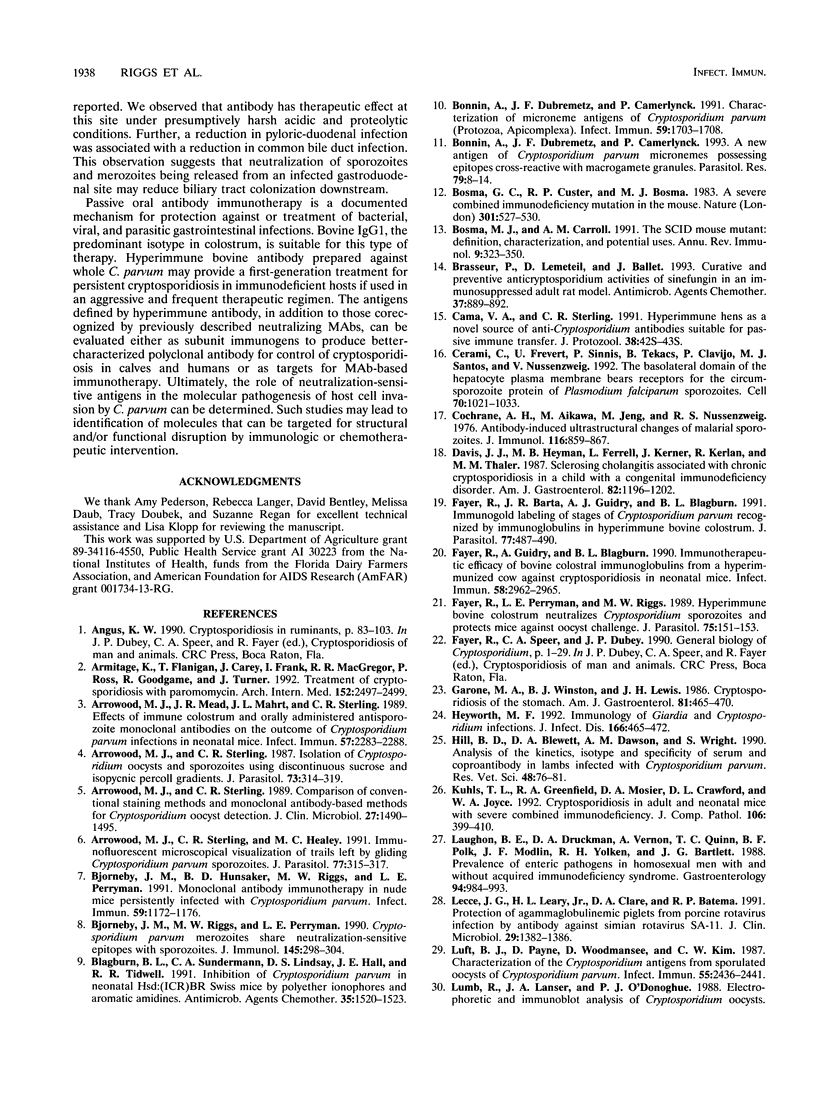
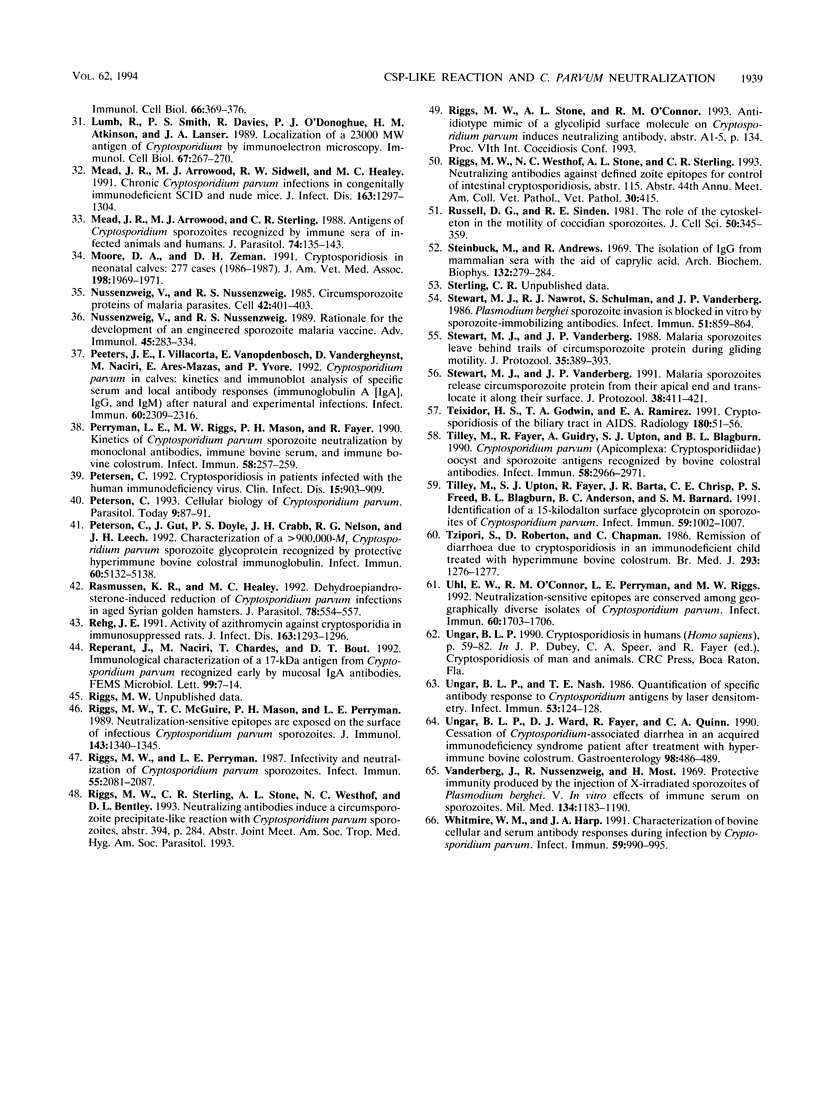
Images in this article
Selected References
These references are in PubMed. This may not be the complete list of references from this article.
- Armitage K., Flanigan T., Carey J., Frank I., MacGregor R. R., Ross P., Goodgame R., Turner J. Treatment of cryptosporidiosis with paromomycin. A report of five cases. Arch Intern Med. 1992 Dec;152(12):2497–2499. [PubMed] [Google Scholar]
- Arrowood M. J., Mead J. R., Mahrt J. L., Sterling C. R. Effects of immune colostrum and orally administered antisporozoite monoclonal antibodies on the outcome of Cryptosporidium parvum infections in neonatal mice. Infect Immun. 1989 Aug;57(8):2283–2288. doi: 10.1128/iai.57.8.2283-2288.1989. [DOI] [PMC free article] [PubMed] [Google Scholar]
- Arrowood M. J., Sterling C. R. Comparison of conventional staining methods and monoclonal antibody-based methods for Cryptosporidium oocyst detection. J Clin Microbiol. 1989 Jul;27(7):1490–1495. doi: 10.1128/jcm.27.7.1490-1495.1989. [DOI] [PMC free article] [PubMed] [Google Scholar]
- Arrowood M. J., Sterling C. R., Healey M. C. Immunofluorescent microscopical visualization of trails left by gliding Cryptosporidium parvum sporozoites. J Parasitol. 1991 Apr;77(2):315–317. [PubMed] [Google Scholar]
- Arrowood M. J., Sterling C. R. Isolation of Cryptosporidium oocysts and sporozoites using discontinuous sucrose and isopycnic Percoll gradients. J Parasitol. 1987 Apr;73(2):314–319. [PubMed] [Google Scholar]
- Bjorneby J. M., Hunsaker B. D., Riggs M. W., Perryman L. E. Monoclonal antibody immunotherapy in nude mice persistently infected with Cryptosporidium parvum. Infect Immun. 1991 Mar;59(3):1172–1176. doi: 10.1128/iai.59.3.1172-1176.1991. [DOI] [PMC free article] [PubMed] [Google Scholar]
- Bjorneby J. M., Riggs M. W., Perryman L. E. Cryptosporidium parvum merozoites share neutralization-sensitive epitopes with sporozoites. J Immunol. 1990 Jul 1;145(1):298–304. [PubMed] [Google Scholar]
- Blagburn B. L., Sundermann C. A., Lindsay D. S., Hall J. E., Tidwell R. R. Inhibition of Cryptosporidium parvum in neonatal Hsd:(ICR)BR Swiss miceby polyether ionophores and aromatic amidines. Antimicrob Agents Chemother. 1991 Jul;35(7):1520–1523. doi: 10.1128/aac.35.7.1520. [DOI] [PMC free article] [PubMed] [Google Scholar]
- Bonnin A., Dubremetz J. F., Camerlynck P. A new antigen of Cryptosporidium parvum micronemes possessing epitopes cross-reactive with macrogamete granules. Parasitol Res. 1993;79(1):8–14. doi: 10.1007/BF00931211. [DOI] [PubMed] [Google Scholar]
- Bonnin A., Dubremetz J. F., Camerlynck P. Characterization of microneme antigens of Cryptosporidium parvum (Protozoa, Apicomplexa). Infect Immun. 1991 May;59(5):1703–1708. doi: 10.1128/iai.59.5.1703-1708.1991. [DOI] [PMC free article] [PubMed] [Google Scholar]
- Bosma G. C., Custer R. P., Bosma M. J. A severe combined immunodeficiency mutation in the mouse. Nature. 1983 Feb 10;301(5900):527–530. doi: 10.1038/301527a0. [DOI] [PubMed] [Google Scholar]
- Bosma M. J., Carroll A. M. The SCID mouse mutant: definition, characterization, and potential uses. Annu Rev Immunol. 1991;9:323–350. doi: 10.1146/annurev.iy.09.040191.001543. [DOI] [PubMed] [Google Scholar]
- Brasseur P., Lemeteil D., Ballet J. J. Curative and preventive anticryptosporidium activities of sinefungin in an immunosuppressed adult rat model. Antimicrob Agents Chemother. 1993 Apr;37(4):889–892. doi: 10.1128/aac.37.4.889. [DOI] [PMC free article] [PubMed] [Google Scholar]
- Cama V. A., Sterling C. R. Hyperimmune hens as a novel source of anti-Cryptosporidium antibodies suitable for passive immune transfer. J Protozool. 1991 Nov-Dec;38(6):42S–43S. [PubMed] [Google Scholar]
- Catsimpoolas N., Meyer E. W. Isolation of soyben hemagglutinin and demonstration of multiple forms by isoelectric focusing. Arch Biochem Biophys. 1969 Jun;132(1):279–285. doi: 10.1016/0003-9861(69)90363-4. [DOI] [PubMed] [Google Scholar]
- Cerami C., Frevert U., Sinnis P., Takacs B., Clavijo P., Santos M. J., Nussenzweig V. The basolateral domain of the hepatocyte plasma membrane bears receptors for the circumsporozoite protein of Plasmodium falciparum sporozoites. Cell. 1992 Sep 18;70(6):1021–1033. doi: 10.1016/0092-8674(92)90251-7. [DOI] [PubMed] [Google Scholar]
- Cochrane A. H., Aikawa M., Jeng M., Nussenzweig R. S. Antibody-induced ultrastructural changes of malarial sporozoites. J Immunol. 1976 Mar;116(3):859–867. [PubMed] [Google Scholar]
- Davis J. J., Heyman M. B., Ferrell L., Kerner J., Kerlan R., Jr, Thaler M. M. Sclerosing cholangitis associated with chronic cryptosporidiosis in a child with a congenital immunodeficiency disorder. Am J Gastroenterol. 1987 Nov;82(11):1196–1202. [PubMed] [Google Scholar]
- Fayer R., Barta J. R., Guidry A. J., Blagburn B. L. Immunogold labeling of stages of Cryptosporidium parvum recognized by immunoglobulins in hyperimmune bovine colostrum. J Parasitol. 1991 Jun;77(3):487–490. [PubMed] [Google Scholar]
- Fayer R., Guidry A., Blagburn B. L. Immunotherapeutic efficacy of bovine colostral immunoglobulins from a hyperimmunized cow against cryptosporidiosis in neonatal mice. Infect Immun. 1990 Sep;58(9):2962–2965. doi: 10.1128/iai.58.9.2962-2965.1990. [DOI] [PMC free article] [PubMed] [Google Scholar]
- Fayer R., Perryman L. E., Riggs M. W. Hyperimmune bovine colostrum neutralizes Cryptosporidium sporozoites and protects mice against oocyst challenge. J Parasitol. 1989 Feb;75(1):151–153. [PubMed] [Google Scholar]
- Garone M. A., Winston B. J., Lewis J. H. Cryptosporidiosis of the stomach. Am J Gastroenterol. 1986 Jun;81(6):465–470. [PubMed] [Google Scholar]
- Heyworth M. F. Immunology of Giardia and Cryptosporidium infections. J Infect Dis. 1992 Sep;166(3):465–472. doi: 10.1093/infdis/166.3.465. [DOI] [PubMed] [Google Scholar]
- Hill B. D., Blewett D. A., Dawson A. M., Wright S. Analysis of the kinetics, isotype and specificity of serum and coproantibody in lambs infected with Cryptosporidium parvum. Res Vet Sci. 1990 Jan;48(1):76–81. [PubMed] [Google Scholar]
- Kuhls T. L., Greenfield R. A., Mosier D. A., Crawford D. L., Joyce W. A. Cryptosporidiosis in adult and neonatal mice with severe combined immunodeficiency. J Comp Pathol. 1992 May;106(4):399–410. doi: 10.1016/0021-9975(92)90024-o. [DOI] [PubMed] [Google Scholar]
- Laughon B. E., Druckman D. A., Vernon A., Quinn T. C., Polk B. F., Modlin J. F., Yolken R. H., Bartlett J. G. Prevalence of enteric pathogens in homosexual men with and without acquired immunodeficiency syndrome. Gastroenterology. 1988 Apr;94(4):984–993. doi: 10.1016/0016-5085(88)90557-4. [DOI] [PubMed] [Google Scholar]
- Lecce J. G., Leary H. L., Jr, Clarke D. A., Batema R. P. Protection of agammaglobulinemic piglets from porcine rotavirus infection by antibody against simian rotavirus SA-11. J Clin Microbiol. 1991 Jul;29(7):1382–1386. doi: 10.1128/jcm.29.7.1382-1386.1991. [DOI] [PMC free article] [PubMed] [Google Scholar]
- Luft B. J., Payne D., Woodmansee D., Kim C. W. Characterization of the Cryptosporidium antigens from sporulated oocysts of Cryptosporidium parvum. Infect Immun. 1987 Oct;55(10):2436–2441. doi: 10.1128/iai.55.10.2436-2441.1987. [DOI] [PMC free article] [PubMed] [Google Scholar]
- Lumb R., Lanser J. A., O'Donoghue P. J. Electrophoretic and immunoblot analysis of Cryptosporidium oocysts. Immunol Cell Biol. 1988 Oct-Dec;66(Pt 5-6):369–376. doi: 10.1038/icb.1988.48. [DOI] [PubMed] [Google Scholar]
- Lumb R., Smith P. S., Davies R., O'Donoghue P. J., Atkinson H. M., Lanser J. A. Localization of a 23,000 MW antigen of Cryptosporidium by immunoelectron microscopy. Immunol Cell Biol. 1989 Aug;67(Pt 4):267–270. doi: 10.1038/icb.1989.40. [DOI] [PubMed] [Google Scholar]
- Mead J. R., Arrowood M. J., Sidwell R. W., Healey M. C. Chronic Cryptosporidium parvum infections in congenitally immunodeficient SCID and nude mice. J Infect Dis. 1991 Jun;163(6):1297–1304. doi: 10.1093/infdis/163.6.1297. [DOI] [PubMed] [Google Scholar]
- Mead J. R., Arrowood M. J., Sterling C. R. Antigens of Cryptosporidium sporozoites recognized by immune sera of infected animals and humans. J Parasitol. 1988 Feb;74(1):135–143. [PubMed] [Google Scholar]
- Moore D. A., Zeman D. H. Cryptosporidiosis in neonatal calves: 277 cases (1986-1987). J Am Vet Med Assoc. 1991 Jun 1;198(11):1969–1971. [PubMed] [Google Scholar]
- Nussenzweig V., Nussenzweig R. S. Circumsporozoite proteins of malaria parasites. Cell. 1985 Sep;42(2):401–403. doi: 10.1016/0092-8674(85)90093-5. [DOI] [PubMed] [Google Scholar]
- Nussenzweig V., Nussenzweig R. S. Rationale for the development of an engineered sporozoite malaria vaccine. Adv Immunol. 1989;45:283–334. doi: 10.1016/s0065-2776(08)60695-1. [DOI] [PubMed] [Google Scholar]
- Peeters J. E., Villacorta I., Vanopdenbosch E., Vandergheynst D., Naciri M., Ares-Mazás E., Yvoré P. Cryptosporidium parvum in calves: kinetics and immunoblot analysis of specific serum and local antibody responses (immunoglobulin A [IgA], IgG, and IgM) after natural and experimental infections. Infect Immun. 1992 Jun;60(6):2309–2316. doi: 10.1128/iai.60.6.2309-2316.1992. [DOI] [PMC free article] [PubMed] [Google Scholar]
- Perryman L. E., Riggs M. W., Mason P. H., Fayer R. Kinetics of Cryptosporidium parvum sporozoite neutralization by monoclonal antibodies, immune bovine serum, and immune bovine colostrum. Infect Immun. 1990 Jan;58(1):257–259. doi: 10.1128/iai.58.1.257-259.1990. [DOI] [PMC free article] [PubMed] [Google Scholar]
- Petersen C. Cellular biology of Cryptosporidium parvum. Parasitol Today. 1993 Mar;9(3):87–91. doi: 10.1016/0169-4758(93)90211-w. [DOI] [PubMed] [Google Scholar]
- Petersen C. Cryptosporidiosis in patients infected with the human immunodeficiency virus. Clin Infect Dis. 1992 Dec;15(6):903–909. doi: 10.1093/clind/15.6.903. [DOI] [PubMed] [Google Scholar]
- Petersen C., Gut J., Doyle P. S., Crabb J. H., Nelson R. G., Leech J. H. Characterization of a > 900,000-M(r) Cryptosporidium parvum sporozoite glycoprotein recognized by protective hyperimmune bovine colostral immunoglobulin. Infect Immun. 1992 Dec;60(12):5132–5138. doi: 10.1128/iai.60.12.5132-5138.1992. [DOI] [PMC free article] [PubMed] [Google Scholar]
- Rasmussen K. R., Healey M. C. Dehydroepiandrosterone-induced reduction of Cryptosporidium parvum infections in aged Syrian golden hamsters. J Parasitol. 1992 Jun;78(3):554–557. [PubMed] [Google Scholar]
- Rehg J. E. Activity of azithromycin against cryptosporidia in immunosuppressed rats. J Infect Dis. 1991 Jun;163(6):1293–1296. doi: 10.1093/infdis/163.6.1293. [DOI] [PubMed] [Google Scholar]
- Reperant J. M., Naciri M., Chardes T., Bout D. T. Immunological characterization of a 17-kDa antigen from Cryptosporidium parvum recognized early by mucosal IgA antibodies. FEMS Microbiol Lett. 1992 Nov 15;78(1):7–14. doi: 10.1016/0378-1097(92)90280-2. [DOI] [PubMed] [Google Scholar]
- Riggs M. W., McGuire T. C., Mason P. H., Perryman L. E. Neutralization-sensitive epitopes are exposed on the surface of infectious Cryptosporidium parvum sporozoites. J Immunol. 1989 Aug 15;143(4):1340–1345. [PubMed] [Google Scholar]
- Riggs M. W., Perryman L. E. Infectivity and neutralization of Cryptosporidium parvum sporozoites. Infect Immun. 1987 Sep;55(9):2081–2087. doi: 10.1128/iai.55.9.2081-2087.1987. [DOI] [PMC free article] [PubMed] [Google Scholar]
- Russell D. G., Sinden R. E. The role of the cytoskeleton in the motility of coccidian sporozoites. J Cell Sci. 1981 Aug;50:345–359. doi: 10.1242/jcs.50.1.345. [DOI] [PubMed] [Google Scholar]
- Stewart M. J., Nawrot R. J., Schulman S., Vanderberg J. P. Plasmodium berghei sporozoite invasion is blocked in vitro by sporozoite-immobilizing antibodies. Infect Immun. 1986 Mar;51(3):859–864. doi: 10.1128/iai.51.3.859-864.1986. [DOI] [PMC free article] [PubMed] [Google Scholar]
- Stewart M. J., Vanderberg J. P. Malaria sporozoites leave behind trails of circumsporozoite protein during gliding motility. J Protozool. 1988 Aug;35(3):389–393. doi: 10.1111/j.1550-7408.1988.tb04115.x. [DOI] [PubMed] [Google Scholar]
- Stewart M. J., Vanderberg J. P. Malaria sporozoites release circumsporozoite protein from their apical end and translocate it along their surface. J Protozool. 1991 Jul-Aug;38(4):411–421. doi: 10.1111/j.1550-7408.1991.tb01379.x. [DOI] [PubMed] [Google Scholar]
- Teixidor H. S., Godwin T. A., Ramirez E. A. Cryptosporidiosis of the biliary tract in AIDS. Radiology. 1991 Jul;180(1):51–56. doi: 10.1148/radiology.180.1.2052722. [DOI] [PubMed] [Google Scholar]
- Tilley M., Fayer R., Guidry A., Upton S. J., Blagburn B. L. Cryptosporidium parvum (Apicomplexa: Cryptosporidiidae) oocyst and sporozoite antigens recognized by bovine colostral antibodies. Infect Immun. 1990 Sep;58(9):2966–2971. doi: 10.1128/iai.58.9.2966-2971.1990. [DOI] [PMC free article] [PubMed] [Google Scholar]
- Tilley M., Upton S. J., Fayer R., Barta J. R., Chrisp C. E., Freed P. S., Blagburn B. L., Anderson B. C., Barnard S. M. Identification of a 15-kilodalton surface glycoprotein on sporozoites of Cryptosporidium parvum. Infect Immun. 1991 Mar;59(3):1002–1007. doi: 10.1128/iai.59.3.1002-1007.1991. [DOI] [PMC free article] [PubMed] [Google Scholar]
- Tzipori S., Roberton D., Chapman C. Remission of diarrhoea due to cryptosporidiosis in an immunodeficient child treated with hyperimmune bovine colostrum. Br Med J (Clin Res Ed) 1986 Nov 15;293(6557):1276–1277. doi: 10.1136/bmj.293.6557.1276. [DOI] [PMC free article] [PubMed] [Google Scholar]
- Uhl E. W., O'Connor R. M., Perryman L. E., Riggs M. W. Neutralization-sensitive epitopes are conserved among geographically diverse isolates of Cryptosporidium parvum. Infect Immun. 1992 Apr;60(4):1703–1706. doi: 10.1128/iai.60.4.1703-1706.1992. [DOI] [PMC free article] [PubMed] [Google Scholar]
- Ungar B. L., Nash T. E. Quantification of specific antibody response to Cryptosporidium antigens by laser densitometry. Infect Immun. 1986 Jul;53(1):124–128. doi: 10.1128/iai.53.1.124-128.1986. [DOI] [PMC free article] [PubMed] [Google Scholar]
- Ungar B. L., Ward D. J., Fayer R., Quinn C. A. Cessation of Cryptosporidium-associated diarrhea in an acquired immunodeficiency syndrome patient after treatment with hyperimmune bovine colostrum. Gastroenterology. 1990 Feb;98(2):486–489. doi: 10.1016/0016-5085(90)90842-o. [DOI] [PubMed] [Google Scholar]
- Vanderberg J., Nussenzweig R., Most H. Protective immunity produced by the injection of x-irradiated sporozoites of Plasmodium berghei. V. In vitro effects of immune serum on sporozoites. Mil Med. 1969 Sep;134(10):1183–1190. [PubMed] [Google Scholar]
- Whitmire W. M., Harp J. A. Characterization of bovine cellular and serum antibody responses during infection by Cryptosporidium parvum. Infect Immun. 1991 Mar;59(3):990–995. doi: 10.1128/iai.59.3.990-995.1991. [DOI] [PMC free article] [PubMed] [Google Scholar]



